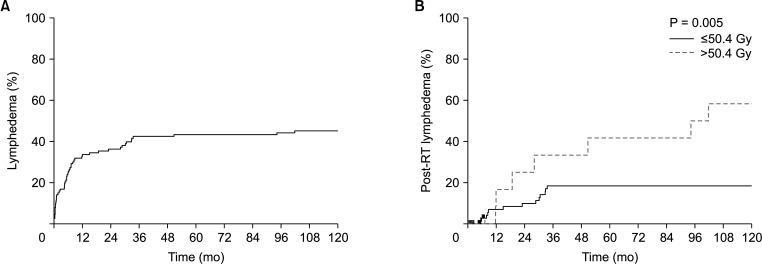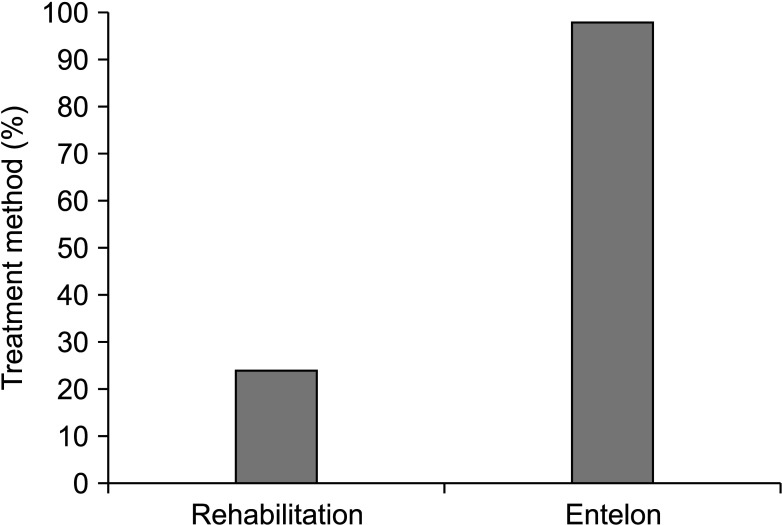Ann Surg Treat Res.
2024 Jun;106(6):337-343. 10.4174/astr.2024.106.6.337.
Lymphedema after regional nodal irradiation for breast cancer: a retrospective cohort study
- Affiliations
-
- 1Department of Nuclear Medicine, Busan Paik Hospital, Inje University College of Medicine, Busan, Korea
- 2Department of Radiation Oncology, Jeju National University Hospital, Jeju National University College of Medicine, Jeju, Korea
- 3Department of General Surgery, Busan Paik Hospital, Inje University College of Medicine, Busan, Korea
- 4Department of Radiation Oncology, Busan Paik Hospital, Inje University College of Medicine, Busan, Korea
- KMID: 2556325
- DOI: http://doi.org/10.4174/astr.2024.106.6.337
Abstract
- Purpose
We aimed to analyze the occurrence of lymphedema as a side effect in patients who underwent regional nodal irradiation (RNI) following surgery for breast cancer.
Methods
This retrospective study was conducted on patients with breast cancer who underwent surgery from July 2014 to October 2020 at Inje University Busan Paik Hospital. The analysis included 113 cT1-3N1-3M0 breast cancer patients who underwent RNI as part of radiotherapy (RT). Mostly, surgeries were performed using breast-conserving surgery (n = 99, 87.6%), except for 14 patients with modified radical mastectomy. The total RT dose for RNI was 45–60 Gy, and the fraction size was 1.8–2.0 Gy. Most patients underwent chemotherapy (n = 98, 86.7%), including taxanes (n = 92, 81.4%).
Results
The median follow-up was 61.1 months (range, 5.0–110.5 months). Lymphedema occurred in 54 patients (47.8%) after surgery. Twenty of them (17.7%) developed a new onset of lymphedema after RT, while 34 (30.1%) detected lymphedema before the completion of RT. Over the follow-up, 16 patients (14.2%) experienced recurrence. High radiation dose (>50.4 Gy) for RNI (P = 0.003) and taxane use (P = 0.038) were related to lymphedema occurrence after RT. Moreover, lymphedema occurrence after RT was also related to recurrence after surgical resection (P = 0.026). Breast-conserving surgery was related to early-onset lymphedema before the completion of RT (P = 0.047). Furthermore, the degree of lymph node dissection (≤4) was related to the overall occurrence of lymphedema (P = 0.045).
Conclusion
Considering a reduction in RNI dose may be beneficial in mitigating the incidence of lymphedema after RT in patients with breast cancer.
Figure
Reference
-
1. Warren LE, Miller CL, Horick N, Skolny MN, Jammallo LS, Sadek BT, et al. The impact of radiation therapy on the risk of lymphedema after treatment for breast cancer: a prospective cohort study. Int J Radiat Oncol Biol Phys. 2014; 88:565–571. PMID: 24411624.2. McDuff SG, Mina AI, Brunelle CL, Salama L, Warren LE, Abouegylah M, et al. Timing of lymphedema after treatment for breast cancer: when are patients most at risk? Int J Radiat Oncol Biol Phys. 2019; 103:62–70. PMID: 30165125.3. Fu MR. Breast cancer-related lymphedema: Symptoms, diagnosis, risk reduction, and management. World J Clin Oncol. 2014; 5:241–247. PMID: 25114841.4. Lee MJ, Beith J, Ward L, Kilbreath S. Lymphedema following taxane-based chemotherapy in women with early breast cancer. Lymphat Res Biol. 2014; 12:282–288. PMID: 25411764.5. Hwang TH, Lee SW. Secondary lymphedema after femoral venous catheterization. Korean J Med. 2013; 84:125–129.6. Rupp J, Hadamitzky C, Henkenberens C, Christiansen H, Steinmann D, Bruns F. Frequency and risk factors for arm lymphedema after multimodal breast-conserving treatment of nodal positive breast cancer: a long-term observation. Radiat Oncol. 2019; 14:39. PMID: 30845971.7. Akezaki Y, Tominaga R, Kikuuchi M, Kurokawa H, Hamada M, Aogi K, et al. Risk factors for lymphedema in breast cancer survivors following axillary lymph node dissection. Prog Rehabil Med. 2019; 4:20190021. PMID: 32789268.8. Donahue PM, MacKenzie A, Filipovic A, Koelmeyer L. Advances in the prevention and treatment of breast cancer-related lymphedema. Breast Cancer Res Treat. 2023; 200:1–14. PMID: 37103598.9. Allam O, Park KE, Chandler L, Mozaffari MA, Ahmad M, Lu X, et al. The impact of radiation on lymphedema: a review of the literature. Gland Surg. 2020; 9:596–602. PMID: 32420295.10. Tandra P, Kallam A, Krishnamurthy J. Identification and management of lymphedema in patients with breast cancer. J Oncol Pract. 2019; 15:255–262. PMID: 31009281.11. Abouegylah M, Elemary O, Munir A, Gouda MY, Arafat WO, Elzawawy S. Evaluation of the effect of axillary radiotherapy dose and the development of lymphedema in breast cancer patients. Breast Care (Basel). 2022; 17:364–370. PMID: 36156914.12. McLaughlin SA, Stout NL, Schaverien MV. Avoiding the swell: advances in lymphedema prevention, detection, and management. Am Soc Clin Oncol Educ Book. 2020; 40:1–10.13. Hopkins JO, Allred J, Hurria A, Jatoi A, Lafky JM, Cohen H, et al. Lymphedema, musculoskeletal events and arm function in older patients receiving adjuvant chemotherapy for breast cancer (Alliance A171302). Breast Cancer Res Treat. 2017; 166:793–808. PMID: 28825227.14. Young-Afat DA, Gregorowitsch ML, van den Bongard DH, Burgmans I, van der Pol CC, Witkamp AJ, et al. Breast edema following breast-conserving surgery and radiotherapy: patient-reported prevalence, determinants, and effect on health-related quality of life. JNCI Cancer Spectr. 2019; 3:pkz011. PMID: 31360894.15. Riches K, Cheung KL, Keeley V. Improving the assessment and diagnosis of breast lymphedema after treatment for breast cancer. Cancers (Basel). 2023; 15:1758. PMID: 36980645.16. Kim N, Kim H, Hwang JH, Park W, Cho WK, Yeo SM, et al. Longitudinal impact of postmastectomy radiotherapy on arm lymphedema in patients with breast cancer: an analysis of serial changes in arm volume measured by infrared optoelectronic volumetry. Radiother Oncol. 2021; 158:167–174. PMID: 33667586.17. Villa G, Campisi CC, Ryan M, Boccardo F, Di Summa P, Frascio M, et al. Procedural recommendations for lymphoscintigraphy in the diagnosis of peripheral lymphedema: the Genoa protocol. Nucl Med Mol Imaging. 2019; 53:47–56. PMID: 30828401.18. Wang D, Lyons D, Skoracki R. Lymphedema: conventional to cutting edge treatment. Semin Intervent Radiol. 2020; 37:295–308. PMID: 32773955.19. Scaglioni MF, Meroni M, Fritsche E. Lymphovenous anastomosis (LVA) for treatment of secondary breast lymphedema: a case report and literature review. Microsurgery. 2021; 41:165–169. PMID: 32678929.20. McNeely ML, Dolgoy ND, Rafn BS, Ghosh S, Ospina PA, Al Onazi MM, et al. Nighttime compression supports improved self-management of breast cancer-related lymphedema: a multicenter randomized controlled trial. Cancer. 2022; 128:587–596. PMID: 34614195.
- Full Text Links
- Actions
-
Cited
- CITED
-
- Close
- Share
- Similar articles
-
- Rapid Lymphedema Progression in Breast Cancer Patient with Previous Forearm Fracture
- Regional nodal irradiation in pT1-2N1 breast cancer patients treated with breast-conserving surgery and whole breast irradiation
- Radiological Considerations in Diagnosing Angiosarcoma Associated With Lymphedema Following Breast Cancer Surgery
- Comparisons of Physiological and Psychosocial Symptoms for Breast Cancer Patients with and without Lymphedema
- Health-Related Quality of Life in Breast Cancer Patients with Lymphedema Who Survived More than One Year after Surgery



